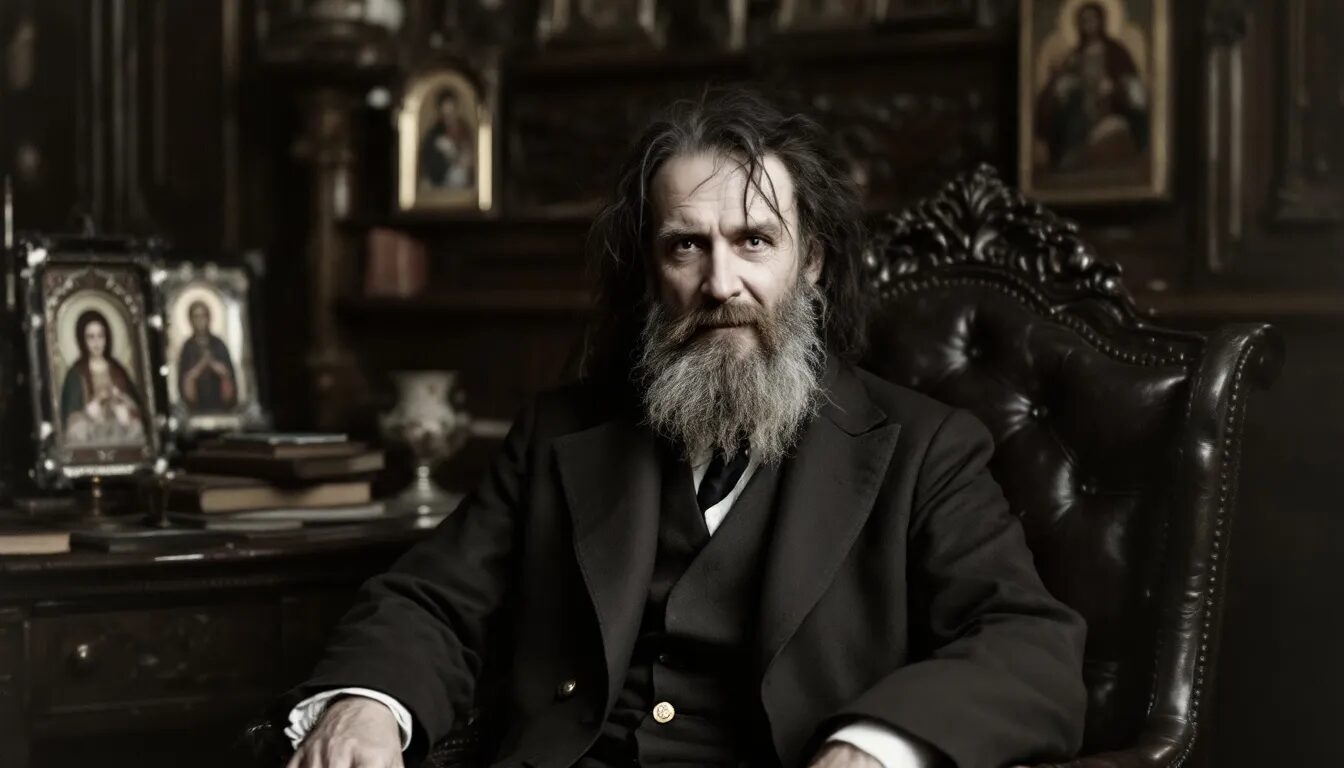TikTok doom‑scrollers swear the “Mad Monk” foresaw everything from AI rebellion to Taylor Swift’s next breakup—so why can’t history let him die?
INTRO: THE BEARD THAT WOULDN’T STAY BURIED


Every few years Grigori Rasputin claws his way out of the Neva River of history and back into pop culture, but 2025 has turned the Siberian mystic into the internet’s favorite end‑times commentator. On TikTok alone, the tag #Rasputin now tops 200 K uploads, while niche variants like #RasputinProphecy 2025 rack up millions of fresh views every weekend.
Clips stitch grainy colorized portraits (see carousel) over synthwave beats, splicing alleged diary lines about “rivers of fire” with real‑time footage of volcanic eruptions and AI‑generated sky demons. The result? A prophecy remix factory that mashes 1916 mysticism with the algorithmic paranoia of Gen Z’s midnight doom‑scroll.
Three big questions drive the frenzy:
- Did Rasputin really predict the future—or did later writers retro‑fit his words?
- Why does his legend hit harder in an era of climate dread, AI angst, and pandemic relapse?
- What does the meme‑ification of prophecy say about the way we crave order inside chaos?
We’ll dive into all three—unpacking the original sources, the modern distortions, and the psychological engine that keeps the “Mad Monk” trending long after the Romanovs turned to dust.
1. A BRIEF HISTORY OF THE “MAD MONK”
Long before he became a TikTok soundbite, Grigori Yefimovich Rasputin—a wandering Siberian peasant born in 1869—wormed his way into the Russian court by allegedly soothing the hemophilic attacks of Tsarevich Alexei. His influence over Empress Alexandra terrified nobles, who eventually murdered him in 1916.
During World War I, his role as an advisor to the czar and czarina intensified, shaping significant decisions that affected Russia’s military and governance. Contemporary diaries mention he warned that “if I am killed by nobles, the dynasty will fall.”
Fourteen months later, the Romanovs were shot in a Yekaterinburg basement. Historians now debate whether Rasputin truly prophesied the empire’s collapse or merely sensed the obvious political rot. For a sober academic deep dive, see Smithsonian Magazine’s forensic breakdown of his murder [link]Smithsonian Magazine.
Early Life as a Siberian Peasant


Rasputin was born to a peasant family in the small village of Pokrovskoye in Siberia. His early years were marked by poverty and hardship, but also by a deepening spirituality. He was known for his controversial interactions with various members of society, including a young woman who later claimed to have been harmed by him.
These early experiences as a Siberian peasant and his deepening spirituality laid the foundation for his future role as a holy man and prophet, eventually propelling him into the heart of Russian society.
Rasputin’s rise to power was a rapid ascent from obscurity to prominence within the Russian imperial family’s inner circle, solidifying his role and significance during a tumultuous period in Russian history.
Early Life as a Siberian Peasant
Grigori Yefimovich Rasputin was born on January 21, 1869, in the remote village of Pokrovskoye, deep within the Russian Empire. As a young man, Rasputin’s life was far from the opulence of the imperial court he would later influence.
Raised in a peasant family, his early years were marked by poverty and a lack of formal education. Despite these humble beginnings, Rasputin developed a profound interest in spirituality and the Bible, which set him apart from his peers.


Rasputin’s father, Yefim, was a church elder, and this religious environment undoubtedly influenced young Grigori. His spiritual journey took a significant turn when he underwent a religious conversion, leading him to join the Khlysty sect.
This mystical group emphasized spiritual purification through ecstatic rituals, a practice that left a lasting impact on Rasputin. These early experiences as a Siberian peasant and his deepening spirituality laid the foundation for his future role as a holy man and prophet, eventually propelling him into the heart of Russian society.
How the Prophecy Portfolio Grew
No original “book of prophecies” has survived. Most quotes derive from:
- Letters dictated to followers—stored in Russian State Archives but first published in 1920s Paris émigré papers. These letters often reference divine interaction, highlighting God’s role in prophetic fulfillment.
- Memoirs by his daughter Maria—written in 1929 while she toured as a circus lion‑tamer. Her memoirs also touch on the biblical significance of Israel in the context of prophecy.
- Sensational pamphlets—mass‑printed during Russia’s civil war to discredit the monarchy. These pamphlets frequently discuss biblical covenants, referencing both the Old Testament and the New Testament.
Over decades, each layer added new disasters—two world wars, Chernobyl, 9/11—retro‑fitted to match vague phrases about “blackened skies” and “metal birds.” The meme economy simply continues the tradition, only faster. This pattern of retrofitting disasters is reminiscent of historical patterns found throughout scripture.
2. 2025: WHY RASPUTIN FITS THE FEED
Doom‑Scroll Culture
Clinical researchers peg doom‑scrolling—the compulsive consumption of negative news—as a top mental‑health drain for under‑30s. Hashtags like #doomscrolling memefy the habit with self‑aware jokes about staring into tragedy. Rasputin clips exploit that loop: each short forecasts an apocalypse, prompting viewers to refresh for proof it’s unfolding.
Algorithmic Alchemy
TikTok’s engine rewards content that sparks debate. “Did he really say that?” comment threads push engagement, so creators splice Rasputin’s blurred face over footage of earthquakes or stock‑market crashes, claim the prophecy matches today, and watch the arguments roll in. Views skyrocket; the legend self‑replicates.
Low‑Barrier Canon
Unlike niche theologians, Rasputin offers a single recognizable visual hook—wild hair, hypnotic stare—and an open‑source mythos. There’s no sacred text to misquote, so remix culture feels no guilt twisting his words.
3. THE “2025 PROPHECIES”—WHAT’S ACTUALLY NEW?
Below is a fact‑check of the five Rasputin lines now circulating in English captions alongside #2025:
Viral Caption | Verifiable Source? | Original Context |
|---|---|---|
“Machines shall awaken with minds of iron and chain mankind.” | ❌ None in archival letters | Likely 2023 AI‑panic fan‑fic; no mention of machines pre‑1916. The word ‘machines’ in this context does not align with any scriptural interpretation. |
“The northern ice will weep red and flood the coasts.” | ⚠️ Vague line in posthumous 1922 tract speaks of “bloody snow” | Probably linked to WWI battlefield imagery, not climate change. Scholars often debate the meaning of such imagery in prophetic texts. |
“When the plague of breathless lungs returns, children will bury their elders in the west.” | ❌ Fabricated after COVID‑19 | First appears in a 2021 Reddit thread |
“A queen of song will rule hearts until she breaks her crown of gold in the dawn of summer.” | ❌ Pop‑culture insertion (Swifties speculating) | Zero archival match |
“Fire over the Black Earth will herald the old empire’s rise.” | ✅ Similar phrase in 1914 letter: “Fire upon the black soil shall awaken the bear.” | Scholars link to WWI Eastern Front, not modern geopolitics. Various verses in biblical prophecies also discuss fire and its symbolic meanings. |
Conclusion: Only one line even loosely echoes any authentic document; the rest are pure meme. Yet each garners hundreds of thousands of likes, proving virality cares little for source integrity.
4. DATA: THE YEAR OF THE MEME PROPHET
- TikTok Metrics: In Q1 2025, #RasputinProphecy views jumped 310 percent, outpacing #Nostradamus by 2 to 1.
- Google Search: “Rasputin predictions 2025” hit peak popularity (100/100) on March 30 after a viral mash‑up comparing solar flares to his “fiery sky” line.
- YouTube Long‑form: Explainer channels like “HistoriCool” saw a 600 percent watch‑time boost on Rasputin videos compared with 2024 averages.
- Book Sales: Dover Press’s public‑domain Rasputin biography entered Amazon’s Top‑20 “Russian History” list in April for the first time since 2006.
5. EXPERTS WEIGH IN—WHY THE LEGEND ENDURES
Dr. Valentina Rybakova, Russian folklore scholar (St. Petersburg State University):“Rasputin embodies the archetype of the holy sinner—both healer and seducer. That ambiguity lets each generation plug in its own fears; today it’s AI. The perception of Rasputin among the Russian people was heavily influenced by rumors and speculation, shaping their views on his character and actions.”
Prof. Elijah Grant, Media Psychology (UCLA):“Prophecy memes give agency to randomness. If a Siberian monk ‘saw it coming,’ then current chaos was inevitable—a comforting fatalism for overwhelmed viewers. For Russians, this belief in his mysticism and power contributed to societal unrest during the final years of the Russian Empire.”
Anna Petrova, curator at the Yusupov Palace Museum:“Visitors ask where Rasputin’s prophecy scrolls are stored. We tell them none exist. They still leave five‑star reviews about ‘feeling the prophecy vibes.’”
Relationship with Nicholas II
Rasputin’s meteoric rise to prominence began in 1905 when he was introduced to Nicholas II and his wife, Alexandra, at the imperial court in St. Petersburg.
The imperial couple, desperate for a solution to their son Alexei’s hemophilia, were immediately captivated by Rasputin’s charismatic presence and his reputed healing powers. Rasputin’s influence over the royal family grew rapidly, and he became a trusted advisor, frequently visiting the palace to offer counsel on matters of state and spirituality.
Nicholas II and Alexandra saw Rasputin as a holy man, a divine emissary who could help them navigate the immense challenges of ruling Russia. His relationship with the imperial family was complex and multifaceted, intertwining personal loyalty with political influence. Rasputin’s presence at court was both a source of comfort for the imperial couple and a point of contention among the Russian elite, who viewed him with suspicion and disdain.
This intricate relationship played a significant role in shaping the course of Russian history, as Rasputin’s counsel often swayed the decisions of the tsar and tsarina.
6. HISTORIANS VS. INFLUENCERS—THE FIGHT FOR THE NARRATIVE
Museums attempt damage control through factual reels, but TikTok incentives favor mystery. Influencer @ProphetHub (2.1 M followers) uploads AI‑voiced Rasputin quotes daily; each earns more reach than the Hermitage Museum’s meticulously cited debunks.
When serious outlets like History.com revisit the real letters, their articles still trend—but comments sections are swamped with “but he predicted 9/11!” believers. Museums attempt damage control through factual reels, but TikTok incentives favor mystery.
Influencer @ProphetHub (2.1 M followers) uploads AI‑voiced Rasputin quotes daily; each earns more reach than the Hermitage Museum’s meticulously cited debunks. When serious outlets like revisit the real letters, their articles still trend—but comments sections are swamped with “but he predicted 9/11!” believers. The feedback loop cements legend over ledger. Prophetic events, such as the return of Jesus with the Armies of Heaven, are often misinterpreted in these narratives.
7. THE PSYCHOLOGY OF MEME PROPHECY
- Pattern‑Seeking Brains: Humans evolved to detect patterns (predator tracks = stay alive). Prophecy memes exploit that instinct, offering cause‑and‑effect narratives in a chaotic news cycle. This taps into the biblical anticipation of hope, where prophecies promise a future filled with blessings and light.
- Participatory Myth‑Making: TikTok stitches and duets let users co‑author the legend, personalizing lines to their regional disasters—Florida hurricanes, Australian bushfires, crypto crashes. These digital interactions often invoke the spirit of prophecy, reflecting the transformative and redemptive qualities attributed to spiritual manifestations.
- Short‑Form Spirituality: Traditional religion declines among young adults; 30‑second prophecy clips offer bite‑sized mysticism without dogma.
- Collective Coping: Sharing an ominous quote after scrolling bleak headlines externalizes anxiety; “It’s not just me, Rasputin warned us!”
8. MEME ECONOMICS—WHO PROFITS?
- Ad‑Revenue Creators: Top five Rasputin prophecy accounts pull estimated $4,000–$8,000/month via TikTok’s Creativity Program.
- Merch: Etsy sells embroidered “Rasputin 2025 Tour” hoodies; a seller told Wired they clear 300 units per drop.
- Tourism: St. Petersburg’s Yusupov Palace markets twilight tours featuring AR overlays of prophecy quotes projected onto the murder site—tickets are up 45 percent YoY.
- Publishers: Public‑domain status lets print‑on‑demand outfits churn $8 paperback “collected prophecies,” ghost‑written by AI, no royalties owed.
9. WHO OWNS THE TRUTH?
The clash illustrates a broader cultural fork: academic rigor vs. algorithmic storytelling. Museums digitize primary documents, but the viral narrative outruns them, challenging God’s divine plans for truth and understanding. Efforts to watermark genuine quotes backfire; conspiracy believers claim censorship, undermining the prophetic fulfillment of the Messiah’s role in bringing clarity and redemption.
The Rasputin cycle mirrors climate‑change denial, vaccine myths, and deepfake politics—each thrives on share‑first, verify‑never dynamics.
The Plot to Kill Rasputin
By 1916, Rasputin’s influence over the Russian throne had become intolerable to many within the Russian elite. A group of nobles, including Prince Felix Yusupov and Grand Duke Dmitry Pavlovich, conspired to kill Rasputin, believing that his removal was essential to saving the Russian Empire from collapse. They saw Rasputin as a malevolent force, a false prophet whose continued presence threatened the future of the monarchy and the country.
On the night of December 29-30, 1916, the conspirators lured Rasputin to Yusupov’s palace under the pretense of a social gathering. There, they served him cakes and wine laced with toxic potassium cyanide.
To their astonishment, the poison seemed to have no effect. In a desperate bid to kill Rasputin, Yusupov shot him multiple times. Even then, Rasputin’s resilience was legendary; he reportedly attempted to escape before being subdued. Finally, his body was thrown into the icy Neva River, where he ultimately drowned.
Rasputin’s murder marked the end of an era and had profound consequences for the imperial family and the Russian Empire. Many saw his death as a fulfillment of biblical prophecy, a harbinger of the tumultuous changes that would soon engulf Russia. The dramatic events of that night have since become a symbol of the chaotic and violent end of the Romanov dynasty, forever entwining Rasputin’s legacy with the fate of the Russian throne.
10. WHAT’S NEXT—THE 2026 FORECAST
If history repeats, Rasputin will fade once a newer prophet‑meme emerges (Baba Vanga? Edgar Cayce?). Yet 2025’s surge leaves an enduring template:
Raw archives + user‑generated remix + doom‑scroll anxiety = evergreen prophecy economy.
Expect B‑roll of Rasputin’s staring eyes to surface after every headline catastrophe—heatwave, stock‑crash, celebrity breakup. The meme prophet isn’t going anywhere; he simply reincarnates with each scroll.
CONCLUSION: THE MONK, THE MEME, THE MIND
A century ago, Russian nobles stuffed Rasputin full of poison, shot him, beat him, drowned him—yet legend says he crawled back up, still breathing. In 2025 he’s resurrected again, not through miracle but through viral video, AI voiceovers, and our own hunger for patterns in the chaos. Whether you treat him as holy healer, sinful charlatan, or pixelated prophet, his story warns that myth spreads faster than fact—and in the age of endless feeds, faster often means first.
So next time a reel claims the “Mad Monk” foresaw your darkest fear, pause before you smash that share button. The only prophecy that always comes true is the one about myths outliving the people who write them—and you just helped it along.
Follow Exorcista for more stories and rituals!











